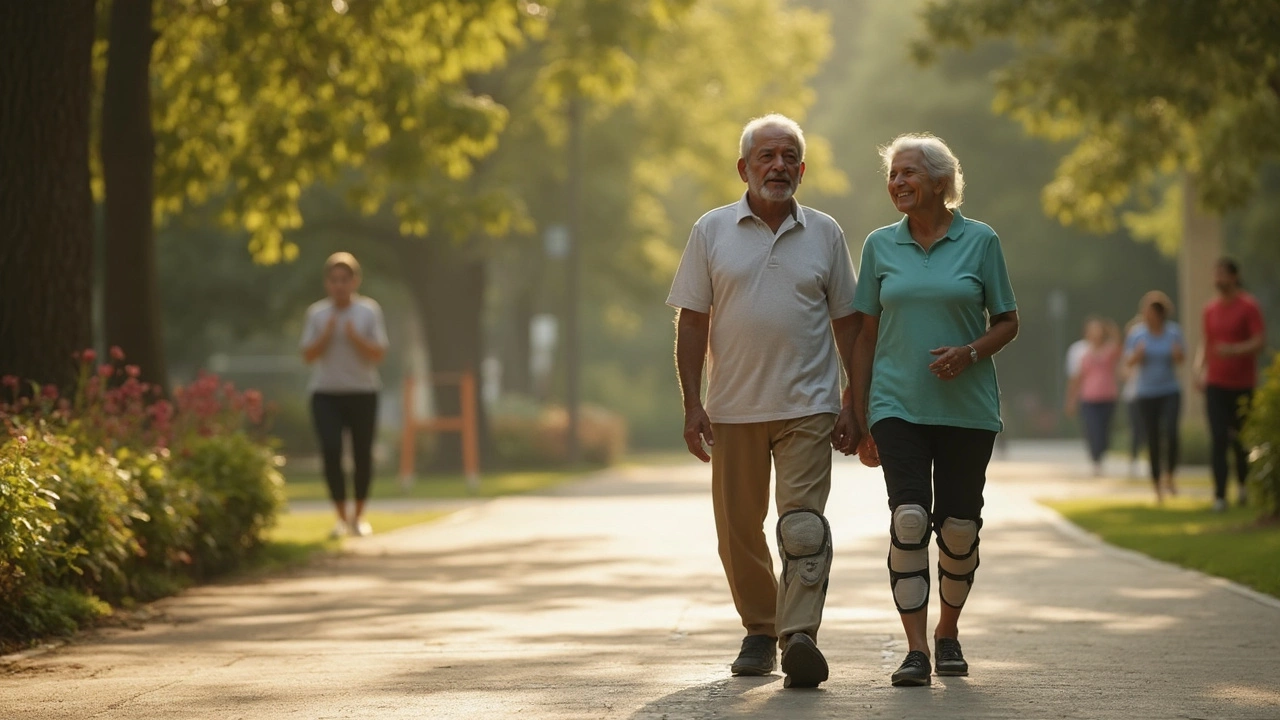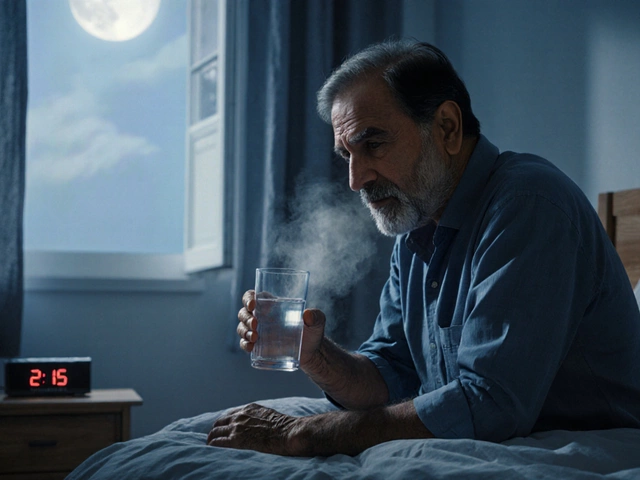
Bumping into the words “bone-on-bone” in a knee X-ray report can set off alarm bells. It sounds final—like there’s no chance to dodge surgery. But here's the thing: While it often means the cartilage is gone, it doesn’t mean the game’s automatically over for your knee. Some folks hobble along for years, others can’t handle stairs by next month.
The advice out there can get confusing—your cousin swears by turmeric, your neighbor got an injection, the doctor hands you a surgery brochure. It’s easy to lose track of what actually helps. The big question: Can you realistically manage a knee with zero cushion left, or are you just buying more time?
- What Does Bone-on-Bone Knee Really Mean?
- Why Surgery Is Often Suggested (And Who Actually Needs It)
- Non-Surgical Approaches: What's Real and What's Hype
- Lifestyle Tweaks That Make a Difference
- Long-Term Outcomes: Living With Bone-on-Bone Without Surgery
What Does Bone-on-Bone Knee Really Mean?
If someone says they have a "bone-on-bone knee," they’re talking about knee osteoarthritis that’s reached the end stage. In plain English, the smooth cartilage that used to let their knee bones slide easily is worn out. Now, bone grinds on bone every time the knee moves. It’s not subtle—pain, swelling, and crunching sounds are pretty common, and stairs can feel almost impossible.
A normal knee has a layer of cartilage about 3 to 5 millimeters thick, acting kind of like a shock absorber. In bone-on-bone, that cushion is wiped out. One MRI study showed that folks with severe osteoarthritis have less than 0.5 mm of cartilage left, if any.
What does that mean? Pain, stiffness, and often a knee that just won’t cooperate. Doctors spot this by X-ray—basically, if there’s little or no space between the thigh bone and shin bone, it’s bone-on-bone. Here's a simple breakdown of what changes as osteoarthritis gets worse:
| Stage | Cartilage Loss | Joint Space (X-ray) | Symptoms |
|---|---|---|---|
| Early OA | Mild | Some narrowing | Occasional pain |
| Moderate OA | More thinning | Obvious space loss | Pain after activity |
| Bone-on-bone | Complete loss | No visible space | Frequent pain, stiffness, crunching |
But—and this is key—not everyone with a bone-on-bone knee feels the same way. Some power through without much help. Others hit a wall fast. The amount of pain honestly doesn’t always match the X-ray, which is why doctors ask a lot about your day-to-day struggles, not just the pictures. So if you’ve heard the term bone-on-bone knee, it means cartilage is gone, not that all hope or function is lost.
Why Surgery Is Often Suggested (And Who Actually Needs It)
So, why does every knee specialist seem to bring up surgery when you complain about that bone-on-bone knee pain? It really boils down to what’s left inside your knee. If all the cartilage is worn away and bone is grinding on bone, odds are, pain and stiffness aren’t going anywhere without some kind of intervention. But here’s the thing: the X-ray alone doesn’t decide if you need a new knee. Your limits and daily life do.
Doctors recommend knee replacement most often when:
- You can’t walk a block without serious pain.
- Stairs feel like climbing Mount Everest, even with a railing.
- Your knee keeps swelling up or buckling without warning.
- Pain medicine and physical therapy just aren’t helping any more.
- Everyday stuff—like getting out of the car or lifting your kid—is a battle.
And it’s not just about age. Some people in their mid-40s need knee replacement, while others in their 70s keep moving with barely any cartilage. It’s about how much your knee affects your happiness, independence, and sleep.
Surgeons don’t rush you into the operating room. They usually want to see if things like exercise, weight loss, bracing, or injections can get you by for a while. They look for what’s called "failed conservative management." If nothing works and your life is on hold, then surgery enters the chat.
Check out how decisions usually break down in a knee clinic:
| Sign/Symptom | Non-Surgical | Surgery Recommended |
|---|---|---|
| Mild/Moderate Pain | Yes | No |
| Severe, Constant Pain | No | Yes |
| Limited Daily Life | No | Yes |
| Pain at Rest/Night | No | Yes |
| Walking Limit Over 1 Block | Yes | No |
The takeaway? Surgery is for folks who can’t get relief any other way and whose knee is running their whole life into the ground, not just anyone with a scary X-ray.

Non-Surgical Approaches: What's Real and What's Hype
It’s easy to get lost in the buzz around miracle cures for bone-on-bone knees. Everyone’s looking for the magic fix so they can dodge surgery, but most quick-fix claims don’t hold up under the microscope. Let’s break down what actually works, what’s just hopeful marketing, and what you really need to know if you’re living with bone-on-bone knee pain.
First, there’s physical therapy. PT doesn’t rebuild missing cartilage, but it does build up the muscles around your knee and keeps the joint moving. That means less pain for many people, and a better shot at doing things you love. Nearly every orthopedic doctor recommends it as the first step—even if you’re 'bone-on-bone.' A 2022 study from JAMA showed that supervised exercise and therapy improved function by up to 30% in older adults with severe knee arthritis.
Weight loss also matters—maybe more than anything else you can do at home. Every extra pound you carry adds four pounds of pressure through your knee with each step. Losing just 10 pounds can cut knee pain by as much as 50% according to research from the Arthritis Foundation.
How about injections? Cortisone shots provide short-term pain relief, but don’t fix the underlying problem. Hyaluronic acid (the so-called "gel shots") sometimes help mild or moderate arthritis, but for true bone-on-bone knees, the evidence is weak. Platelet-rich plasma (PRP) or stem-cell injections? They sound cool, but solid long-term proof is still missing. Insurance might not cover them, and costs can run over $2,000 per treatment.
- Physical therapy: Good for pain, can delay need for surgery
- Weight loss: Relieves stress on knee, big impact for most folks
- Cortisone shots: Short window of relief, not a fix
- Hyaluronic acid: Sometimes helps, but not a game changer for bone-on-bone
- PRP/Stem cells: Experimental, expensive, not guaranteed to help
Supplements are everywhere. Glucosamine and chondroitin have mixed results—some get mild relief, others feel nothing. Turmeric is hyped by many people (including my mom!), but there’s no strong evidence it repairs joints or changes much long term.
| Treatment | Evidence of Effectiveness | Average Cost |
|---|---|---|
| Physical Therapy | Strong for pain relief | $50–$150/session |
| Weight Loss | Very strong, especially for overweight adults | Varies |
| Cortisone Injections | Temporary relief (weeks to months) | $100–$300/shot |
| Hyaluronic Acid | Weak for severe cases | $300–$800/shot |
| PRP/Stem Cell | No proven long-term benefit | $2,000+/treatment |
| Supplements | Mixed, mostly placebo | $15–$60/month |
At the end of the day, non-surgical options can help you push off surgery or manage pain, but nothing rebuilds lost cartilage. Stick to what’s proven. Be wary of anything that promises a permanent fix without surgery—it’s usually too good to be true.
Lifestyle Tweaks That Make a Difference
If your knee joint’s lost its cushion, even small changes in your daily habits can put less stress on the joint and help you move better. It’s not all about fancy gadgets or miracle pills—simple tweaks add up. I’ve seen people push off surgery for years just by being smart about these basics.
The number one tip: Drop a few pounds if you can. Every extra kilo puts about four more kilos of pressure on your knees, so even losing five kilos can give your joints a break. A 2022 orthopedic review showed that people who lost 10% of their body weight reported less knee pain and better function within six months.
Making movement part of your day is huge, even if it sounds hard with pain. Focus on low-impact stuff like:
- Swimming or water aerobics (the pool supports your weight, so less grinding on the knee)
- Stationary cycling
- Walking on flat, soft surfaces (skip the hills and stairs)
- Gentle yoga or stretching
Building up the muscles around your knee can make a bigger difference than you’d think. The goal is to get your quads, hamstrings, and calves stronger so they help with the load. A short exercise plan from a physio usually focuses on these areas. Stick with it—results can show up in a month or two.
Here’s a quick look at how some daily knee habits work out according to clinical studies:
| Lifestyle Change | Pain Reduction (Avg %) | Improved Function (Avg %) |
|---|---|---|
| Weight loss (10% body weight) | 30-50% | 20-40% |
| Regular low-impact exercise | 20-40% | 20-35% |
| Structured physical therapy | 25-40% | 25-45% |
Don’t forget the little stuff—it matters. Swapping heavy grocery bags for a cart, using the elevator instead of stairs, or buying shoes with more cushion can all make your bone-on-bone knee feel less angry.
"You can’t regrow cartilage, but you can strengthen everything around the knee to help fill the gap," says Dr. Michael Fredericson, professor of orthopedics at Stanford.
Everyone’s knee responds differently, so go at your own pace. Track what’s actually helping—if that means keeping a little notebook or using your phone’s notes, it’s worth it. Over time, these tweaks probably won’t regrow lost cartilage, but they can absolutely help you walk around with less pain for longer.

Long-Term Outcomes: Living With Bone-on-Bone Without Surgery
So what happens if you skip surgery and stick it out with bone-on-bone knees? The answer: results really depend on your pain tolerance, lifestyle, and what you expect from your knees. It's not a death sentence for everyone, but it does mean you might need to get creative and accept trade-offs.
The most important thing to know is that bone-on-bone isn't the same for everyone. Some folks get by with daily routines, managing pain with over-the-counter meds and the occasional cortisone shot. Others can’t walk without limping, and day-to-day stuff (think stairs or long walks) becomes a struggle.
According to the bone-on-bone knee studies, about 35% of people with this stage of osteoarthritis never end up getting a knee replacement. They rely on pain management, reduced activity, and support devices like canes or knee braces. These adjustments may not sound fun, but plenty of people would rather tweak their lifestyle than face surgery or a long recovery.
- Mobility: Most people stay independent, but your walking speed usually drops. Long hikes or high-impact sports are off the table.
- Pain: Flare-ups can still happen, especially after heavy use. During bad days, even standing at the stove to cook can hurt.
- Joint shape: Over time, knees can become more stiff or even a little crooked. The body sometimes adapts, but you can lose a bit of flexibility.
- Medications: Folks often go from acetaminophen to stronger meds over the years. Long-term NSAID use can bring stomach or kidney issues, though, so it’s not a forever solution.
If you’re wondering what this actually looks like in numbers, here’s a quick snapshot from a big knee study:
| Years After Diagnosis | Still Avoiding Surgery (%) | Still Walking Independently (%) |
|---|---|---|
| 1 year | 95% | 90% |
| 5 years | 65% | 72% |
| 10 years | 35% | 55% |
Some tricks that help long-term are weight loss (yes, even 5% makes a real difference), keeping up with gentle exercise, and using supports. Aquatic workouts and cycling are huge with people who make it work without surgery. Think about small wins, not miracle fixes.
It all boils down to your goals. If you want to dance at a wedding or chase grandkids at the park, you might be frustrated. If you’re okay with a slower pace and manage your pain smartly, it’s totally possible to live semi-comfortably with bone-on-bone knees for a long time.





Rohan Talvani
I am a manufacturing expert with over 15 years of experience in streamlining production processes and enhancing operational efficiency. My work often takes me into the technical nitty-gritty of production, but I have a keen interest in writing about medicine in India—an intersection of tradition and modern practices that captivates me. I strive to incorporate innovative approaches in everything I do, whether in my professional role or as an author. My passion for writing about health topics stems from a strong belief in knowledge sharing and its potential to bring about positive changes.
view all postsWrite a comment